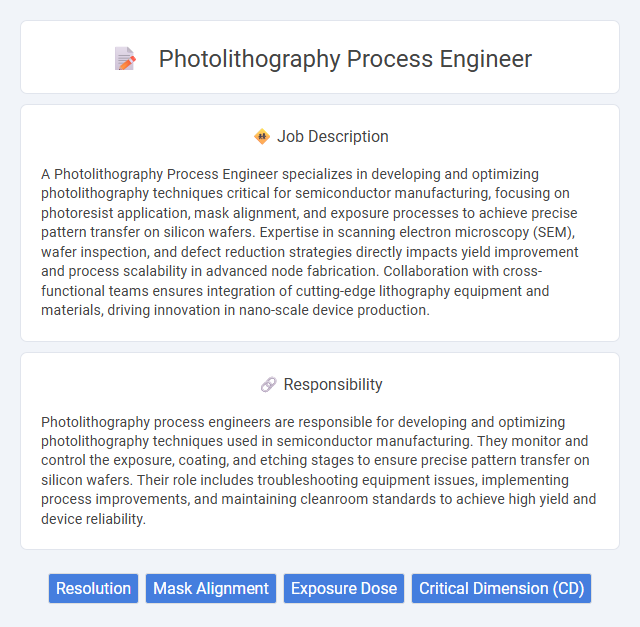
A Photolithography Process Engineer specializes in developing and optimizing photolithography techniques critical for semiconductor manufacturing, focusing on photoresist application, mask alignment, and exposure processes to achieve precise pattern transfer on silicon wafers. Expertise in scanning electron microscopy (SEM), wafer inspection, and defect reduction strategies directly impacts yield improvement and process scalability in advanced node fabrication. Collaboration with cross-functional teams ensures integration of cutting-edge lithography equipment and materials, driving innovation in nano-scale device production.
Individuals with strong attention to detail and problem-solving skills may likely thrive as photolithography process engineers, given the precision required in semiconductor manufacturing. Candidates comfortable with repetitive tasks and working in cleanroom environments probably find this role suitable, as it demands strict adherence to protocols and consistent process monitoring. Those who prefer dynamic, less controlled settings might not find this position ideal due to its structured and highly regulated nature.
Qualification
A Photolithography Process Engineer must possess a strong background in semiconductor manufacturing, typically holding a bachelor's or master's degree in electrical engineering, materials science, or a related field. Expertise in photolithography equipment, photoresist materials, and process optimization techniques is essential, along with proficiency in data analysis and process control software. Experience with cleanroom protocols, defect analysis, and collaboration with cross-functional teams ensures effective integration of lithographic processes in advanced semiconductor fabrication.
Responsibility
Photolithography process engineers are responsible for developing and optimizing photolithography techniques used in semiconductor manufacturing. They monitor and control the exposure, coating, and etching stages to ensure precise pattern transfer on silicon wafers. Their role includes troubleshooting equipment issues, implementing process improvements, and maintaining cleanroom standards to achieve high yield and device reliability.
Benefit
A photolithography process engineer likely enjoys benefits such as competitive salaries, opportunities for career advancement, and access to cutting-edge technology in semiconductor manufacturing. Health insurance, retirement plans, and professional development programs are commonly offered to support employee well-being and growth. The role may also provide a collaborative work environment that fosters innovation and skill enhancement.
Challenge
The Photolithography process engineer job likely presents challenges related to maintaining precision in pattern transfer at nanometer scales, which demands rigorous control of equipment and materials. Managing variability in photoresist coatings and exposure parameters could pose frequent issues requiring innovative troubleshooting. Rapid advancements in technology may also require constant adaptation to new techniques and strict adherence to process optimization.
Career Advancement
Photolithography process engineers play a critical role in semiconductor manufacturing, ensuring precision in pattern transfer onto wafers. Career advancement opportunities include transitioning into senior process engineering roles, equipment engineering, or R&D positions focused on next-generation lithography techniques. Mastery of advanced photolithography tools, in-depth expertise in process optimization, and continuous learning about emerging technologies significantly enhance promotion prospects in this specialized field.
Key Terms
Resolution
Photolithography process engineers specialize in optimizing resolution by manipulating exposure parameters, photoresist chemistry, and equipment calibration to achieve precise pattern transfer on semiconductor wafers. They analyze critical dimensions and line edge roughness to enhance feature fidelity in advanced node devices, ensuring compliance with stringent design rules. Mastery of resolution enhancement techniques such as optical proximity correction and phase-shift masks is essential for driving semiconductor manufacturing innovation.
Mask Alignment
A Photolithography Process Engineer specializing in mask alignment optimizes the precision of photoresist pattern transfers onto semiconductor wafers, ensuring critical feature registration within nanometer-scale tolerances. Mastery in advanced alignment techniques, such as infrared and optical alignment systems, is essential to minimize overlay errors and improve yield in IC fabrication. Expertise in equipment calibration, defect analysis, and process control directly impacts device performance and manufacturing efficiency.
Exposure Dose
Exposure dose in photolithography is a crucial parameter controlling the amount of energy delivered to the photoresist during wafer patterning. Precise calibration of the exposure dose ensures optimal feature resolution, critical dimension control, and process yield in semiconductor manufacturing. Process engineers analyze dose-response curves and adjust parameters to minimize defects and achieve uniform resist profiles across the wafer.
Critical Dimension (CD)
A Photolithography Process Engineer specializing in Critical Dimension (CD) ensures precise control over feature sizes during semiconductor fabrication to meet stringent design specifications. Utilizing advanced metrology tools and process optimization techniques, they minimize CD variations that can affect chip performance and yield. Mastery of exposure parameters, resist chemistry, and etch profiles is essential for maintaining CD uniformity across wafer batches.
 kuljobs.com
kuljobs.com